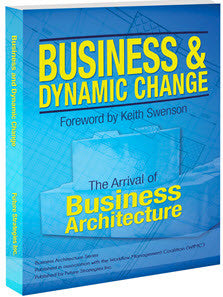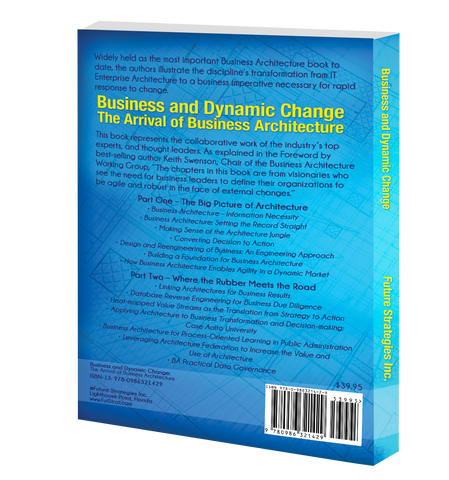Business and Dynamic Change Digital Edition
Retail Price : $ 39.95
Your Price : $ 10.97
You Save : 73 %
Size: 19MB, 251 pages.
Digital BENEFITS: Enjoy immediate PDF download, live URLs, searchable text, graphics and charts in color. No shipping charges. Delivered in unzipped PDF; mobile device-friendly
Business and Dynamic Change
The Arrival of Business Architecture
The chapters in this book are contributed by visionaries who see the need for business leaders to define their organizations to be agile and robust in the face of external changes. The goal is to build something knowing that it will be changed; so that you have no need to go back to the metaphorical drawing board for every market condition change.
In his Foreword, Keith Swenson asks you, "Consider what it means to say that the business will adapt in the face of external changes. The business architecture is not simply a model that specifies how to run the business for now and the next few years. The people making the architecture cannot know the pressures that will be faced. Instead, it must support leaders and executives within the organization to make consistently good decisions on how to adapt their practices. The architecture is not a plan that anticipates all the decisions; instead it embodies a set of core guiding principles that enable decision-making."
Understand that the term “business” used this way is not limited to for-profit enterprises but includes all forms of organizations that have a strategic need to accomplish goals. Pragmatically speaking, business architecture is the conceptual understanding that people have on why particular choices were made in forming the organization in a particular way.
This book will help you understand your options and how to relate them to your own organization.
Who should read this book?This book will stimulate thinking about a more complete approach to business architecture. As such, it is imperative reading for executives, managers, business analysts, and IT professionals that require an understanding of the structural relationships of the components of an enterprise. |
The current situation
We are at the point of applying these ideas to architecting organizations as a whole. Many parallel efforts have evolved and are currently in use. As a result, there is a need to make some sense out of the jungle of ideas, concepts and approaches to architecture applied to organizations. The architecture of an organization can be divided into different aspects that focus on particular needs or purpose, for example:
- Strategic needs or operational needs.
- Important external content with specific time horizon where change is the issue and dynamics of the organization play a critical role.
The book addresses these issues in two main sections:
Part One – The Big Picture of Architecture
Getting your arms (and your head) around the whole architecture space is not an easy task. These chapters introduce several variations with a lot of commonality on how to look at business architecture. Each of these has been used with success. With over 65 management models today and as many methodologies and analytical approaches, the big picture is really a work in progress. As the ideas are sorted out and worked into viable frameworks for representing an organization the value of business architecture efforts will greatly increase.
Part Two – Where the Rubber Meets the Road
Sometimes you need to get into the gritty details of the architecture work. This section introduces some specific uses and applications of business architecture concepts. Some are enterprise-wide and some are specific to certain aspects of the architecture. In each case there is considerable value in applying the architecture concepts described, supported by the writers’ rationale and drivers behind the efforts.
Who should read this book?
This book will stimulate thinking about a more complete approach to business architecture. As such, it is imperative reading for executives, managers, business analysts, and IT professionals that require an understanding of the structural relationships of the components of an enterprise.
Table of Contents
Foreword
Keith D. Swenson, WfMC Chair and Vice President, Fujitsu America
Introduction and Overview
Frank F. Kowalkowski, Knowledge Consultants, Inc., and Gil Laware, Information By Design, USA
Part One – The Big Picture of Architecture
Business Architecture – Information Necessity
Michael G. Miller, HSBC Global United States
Business Architecture: Setting the Record Straight
William Ulrich, TSG, Inc., USA, Whynde Kuehn, S2E Consulting Inc., USA
Making Sense out of the Architecture Jungle
Frank F. Kowalkowski, Knowledge Consultants, Inc., USA
Converting Decision-to-Action
Gil Laware, Information By Design, USA
Design and Reengineering of Business: An Engineering Approach
Brian K Seitz, Intellectual Arbitrage Group, USA
Building a foundation for business architecture
Martin Klubeck, Michael Langthorne, Donald Padgett
How Business Architecture Enables Agility in a Dynamic Market
Dr Michael Poulin, Clingstone Ltd., UK
Part Two – Where the Rubber Meets the Road
Linking Architectures for Business Results
Jude Chagas Pereira, IYCON
Database Reverse Engineering for Business
Michael Blaha, Modelsoft Consulting Corp
Heat-mapped Value Streams as the Translation from Strategy to Action
J. Bryan Lail, Stephanie Ramsay, Ralph Shaw, Raytheon, U.S.
Applying Architecture to business transformation and decision making: Case Aalto University
Patrik Maltusch, Aalto University, Finland and Virpi Nieminen, QPR Software, Finland
Business Architecture for Process-Oriented Learning in Public Administration
Darius Silingas, No Magic Europe, Lithuania; Barbara Thönssen, FHNW, Switzerland; Alfonso Pierantonio, University of L’Aquila, Italy, Nesat Efendioglu, Robert Woitsch, BOC Asset Management, Austria
Leveraging Architecture Federation to Increase the Value and Use of Architecture
David Rice, EA Frameworks, LLC, USA
BA Practical Data Governance
Michael S. Connor, American Family Insurance, U.S.A.
Part 3: Appendices
Acknowledgements:
The publishers acknowledge with thanks the concepts and guidance for this book provided by Frank Kowalkowski and Gilbert Laware. Formed under the auspices of WfMC.org, the members of the newly-formed Business Architecture Working Group are also active contributors.





